Single-Ply Roofing • What It Is, Types, Materials & More
By Jack Gray, Roof Online Editor • Last updated May 24, 2023
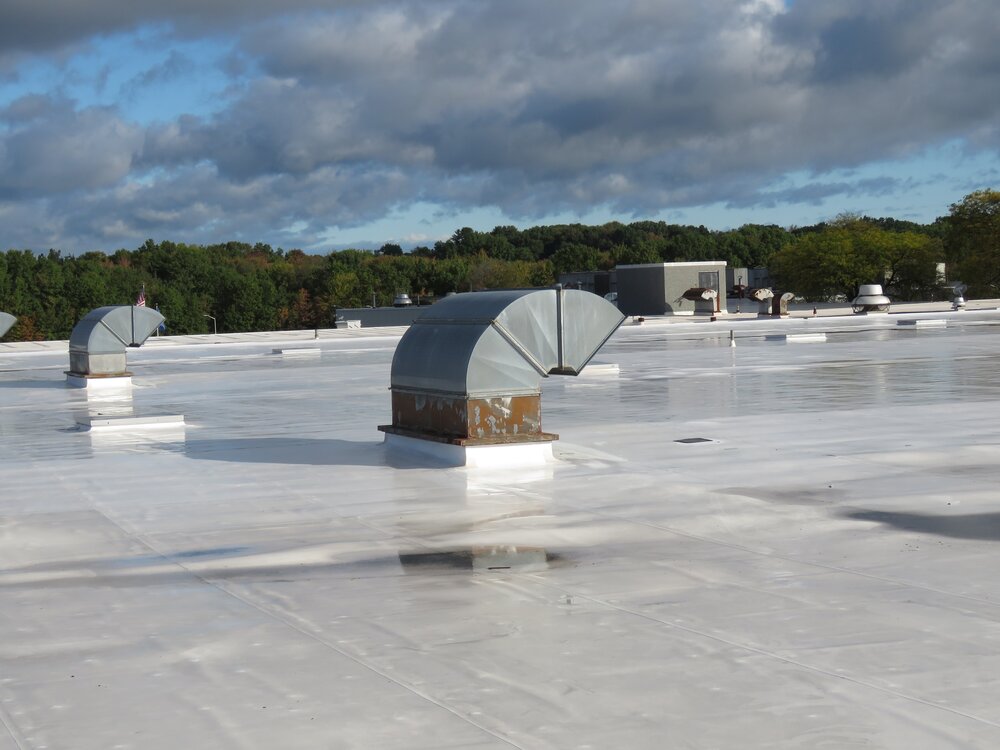
Table of Contents
Introduction
The majority of all new commercial roof installations use a single-ply roofing system. (We’re talking about flat roofs, of course. A single ply membrane is almost never appropriate for a pitched roof. And a flat roof is more correctly called a “low-slope roof”, by the way.)
Although modifications and reformulations of single-ply materials sometimes lead to a roofing manufacturer designating their product as a new type of membrane, there are 8 commonly-recognized types of single-ply roof membranes found on roofs today.
We list them here and provide some basic information about each one.
What is Single-Ply Roofing?
Single-ply systems were first called “single-ply systems” to distinguish this type of roofing from hot asphalt and coal tar pitch built-up roofing systems. Built-up systems have membranes formed from multiple layers of bitumen and reinforcement felts which are called “plies”.
According to the Glossary of Roofing Terms published by the International Institute of Building Enclosure Consultants (IIBEC), the official definition of single-ply roofing is as follows:
“A roofing system in which the principal roof covering is a single layer flexible membrane, often of thermoset, thermoplastic, or polymer modified bituminous compounds. Generally there are six types of single ply roofing systems 1) Fully-adhered, 2) Loose-laid, 3) Mechanically-fastened, 4) Partially-adhered, 5) Protected membrane roof, and 6) Self-adhering.”
These six types refer to the attachment method of the single-ply roofs, not to the type of material used in the single ply membrane system.
Single ply roofing membranes are also classified according to whether the roofing materials are thermoset or thermoplastic.
Thermoplastic Single-Ply Membranes
Thermoplastic single-ply roofing membranes are made of various types of synthetic polymers (TPO, PVC) that can be softened by an increase in temperature and will re-harden when the temperature decreases. A thermoplastic single ply membrane can be re-softened or melted and then cooled again without destroying its original properties.
The material will become liquid when heated to high enough temperatures; this allows the membrane seams to be formed using heat welding with super hot air.
Thermoplastics tend to have higher tensile strengths than thermosets which makes them more resistant to punctures and tears.
Thermoset Single-Ply Membranes
Thermoset single-ply roofing membranes are made of various synthetic rubbers (elastomers). They are called “thermoset” because the material hardens, or sets, when heated. This is called “vulcanization”.
Thermosets form a chemical bond when subjected to heat. The heat causes the molecules in the material to cross-link and form an irreversible bond, making it impossible to re-soften or melt the material without destroying its original properties.
Thermoset materials cannot be melted or reshaped like thermoplastic materials once they have fully cured. Thermoset single ply membranes cannot be heat-welded and require adhesive or adhesive tape for seaming or making repairs.
EPDM is by far the most common thermoset used today.
Attachment Methods for Single-Ply Membrane Roofing
The overwhelming majority of single-ply roof systems are installed using one of three attachment methods:
Fully-Adhered Systems
Fully-adhered means that the entire single-ply roof membrane is bonded to the cover board or the above-deck insulation with a specially-formulated membrane adhesive.
The rest of the single ply membrane system (the insulation and cover board under the membrane) may be attached to the roof deck using either adhesives or fasteners, but no fasteners will penetrate the single-ply membrane in a fully-adhered system, which is a benefit of this method.
Fully-adhered systems tend to suffer from membrane shrinkage far less than mechanically-attached and especially ballasted systems.
Fully adhered systems are lightweight and suitable for various building sizes and shapes, including high-slope applications.
This method typically results in the longest-lasting roof, everything else being equal.
Mechanically-Attached Systems
Mechanically-attached, also called “mechanically-fastened”, most often means that the single ply membrane sheets are individually fastened down into the roof deck using a line of fasteners which are normally hidden inside the seams which join the sheets together, where the sheets overlap.
Sometimes a mechanically-attached system will not use the seams, and the lines of fasteners will simply be installed at regular intervals across the roof, each line being covered by a separate strip of membrane material.
Sometimes batten strips (flat, narrow strips of plastic or metal) will be included along the fastener lines for increased securement.
These systems are lightweight and can be used for buildings of all sizes and configurations.
This method normally results in the second longest-lasting roof, everything else being equal.
Ballasted Systems
“Ballasted” refers to an attachment system in which all of the layers of the roof system are loose-laid, without using any fasteners or adhesives. Ballasted systems depend on ballast weight to hold the entire roof system in place.
Ballasted single-ply roofing systems offer a quick installation at a relatively low cost. Ballasted systems are typically used in big new construction jobs but can also work for roof replacements or recovery projects, as long as the existing structure can handle the extra weight.
Installation of ballasted systems is generally considered to be the easiest among all types of roofing systems.
The ballast is usually installed directly on top of the single-ply roof membrane, although a geotextile may be laid over the membrane to protect it from the ballast.
The ballast used for securing roof systems normally consists of river-washed stones (no sharp edges), concrete pavers, or a combination of the two.
It’s common to see stone ballast used on most of the roof with the heavier and more stable concrete pavers installed at the corners for increased wind resistance.
The ballast is installed across the entire surface of the roof at an installed weight of 10 – 20 pounds per square foot.
Ballasted systems usually have the shortest life expectancies, with the shortest warranty periods.
Is Modified Bitumen a Single-Ply Roof Membrane?
There is also some confusion in the roofing industry as to whether modified bitumen systems should be placed in the single-ply category or considered a built-up roof system. Over the years, we’ve seen various reputable roofing industry experts categorize modified bitumen as both.
A modified bitumen roof membrane isn’t really built-up on site the way a true built-up roof system is, although a case can be made that out of all other roof systems, it’s most similar to a BUR. We prefer to categorize modified-bitumen as it’s own separate type of roofing.
We don’t consider modified bitumen to be a single-ply roof membrane for the simple reason that almost all modified bitumen roofs have two plies. You can read more in our article on modified bitumen.
Types of Single-Ply Membrane Materials
CPE (Chlorinated Polyethylene) Single-Ply Membrane Roofing

- Colors: White, Gray
- Attachment Method: Fully-Adhered, Mechanically Fastened, Ballasted
- Seaming or Patching Method: Hot Air Welded
- Asphalt Compatibility: Good
- Resistance to Oils, Coolants, and Grease: Excellent (but not gasoline)
- In Use Since: 1970’s
About CPE Single-Ply Roofing Systems
Although CPE is not a commonly used single-ply roofing membrane, it is still manufactured and can sometimes be found on commercial roofs. I’ve personally seen more than one existing roof that had a CPE membrane. CPE is similar to CPSE (Hypalon) membranes.
CPE roofing membranes were introduced in Europe in 1973 and in the United States in 1978. CPE does not need plasticizers to make it flexible and elastic, but it tends to shrink a lot, so most CPE membranes are reinforced.
Some manufacturers claim that CPE does not cure and remains thermoplastic indefinitely, but this is not entirely true based on real-world experience. CPE does have a tendency to cure after installation, which can make repairing the membrane more difficult as it ages.
Repair procedures may have to include cleaning, treatment with solvent, priming, and the use of a pressure-sensitive adhesive.
CPE does well with asphalt, and manufacturers have been known to allow CPE membrane installation using asphalt as an adhesive.
CSPE “Hypalon” Single-Ply Membrane (Chlorosulfonated Polyethylene)
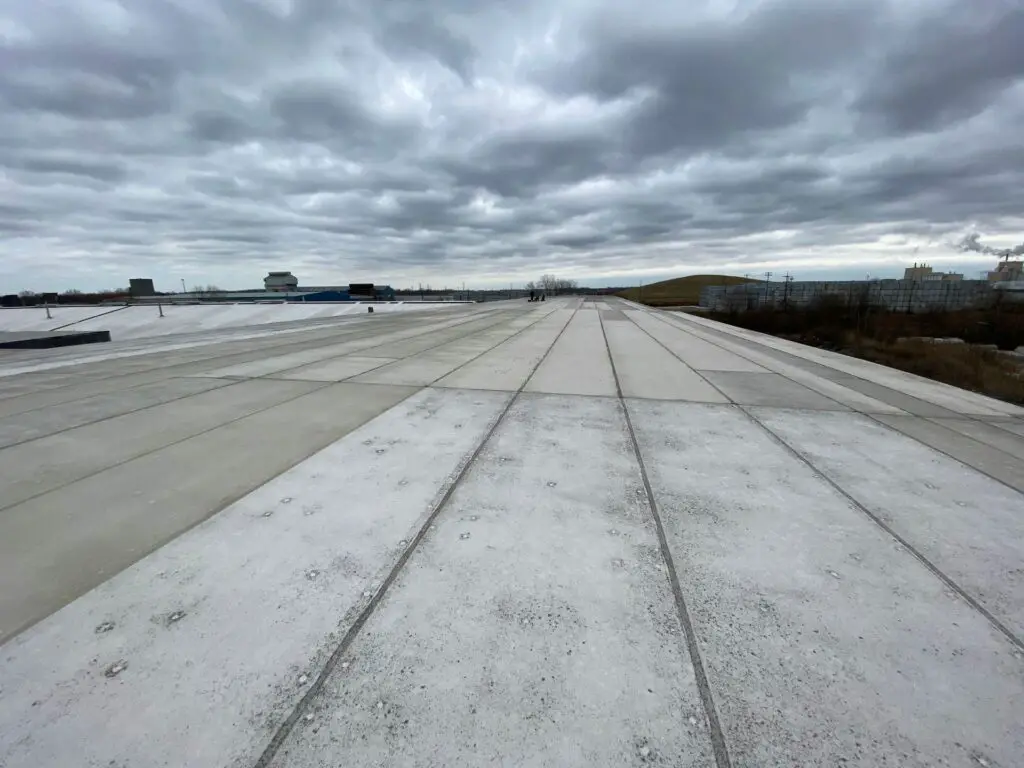
- Colors: White (typical), Various Others
- Attachment Method: Fully-Adhered, Mechanically Fastened, Ballasted
- Seaming or Patching Method: Hot Air Welded (typical), Adhesive
- Asphalt Compatibility: Good
- Resistance to Oils, Coolants, and Grease: Animal Fats – Excellent; Petroleum – Fair
- In Use Since: Mid-1960’s, US production stopped in 2010
About Hypalon Single-Ply Roofing Systems
Hypalon is a type of roofing material formerly used in low-slope or flat roofing applications. It is made of chlorosulfonated polyethylene (CSPE), a synthetic rubber material that is highly durable and resistant to environmental factors such as UV radiation, ozone, and extreme temperatures.
Hypalon roof membranes are a type of single-ply roofing and can be installed as fully adhered, mechanically attached, or ballasted systems. They are known for their excellent resistance to chemicals and pollutants, which made them a popular choice for industrial and commercial roofing applications.
To learn more about Hypalon, see our Hypalon (CSPE) Roofing page.
EPDM Single-Ply Membrane Roofing (Ethylene Propylene Diene Monomer)
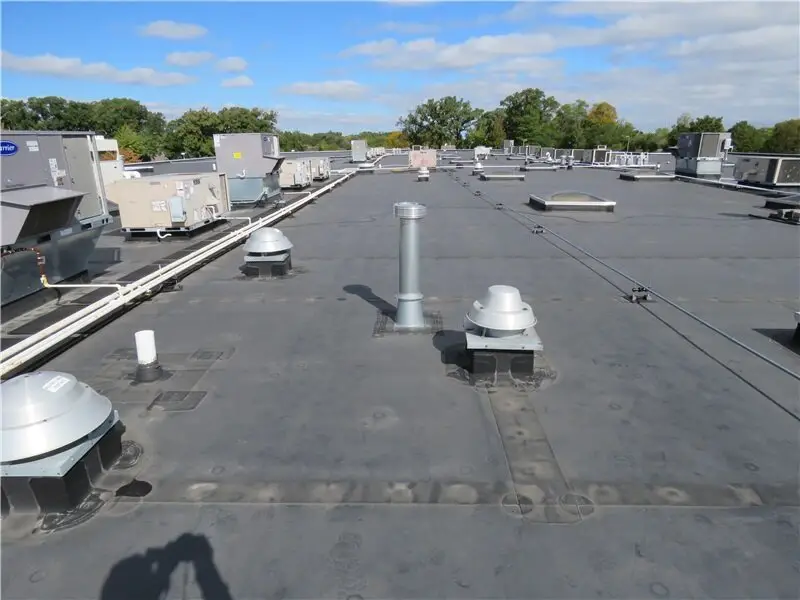
- Colors: Black (typical), White
- Attachment Method: Fully-Adhered, Mechanically Fastened, Ballasted
- Seaming or Patching Method: Adhesive or Adhesive Tape
- Asphalt Compatibility: Fair
- Resistance to Oils, Coolants, and Grease: Poor
- In Use Since: 1970’s
About EPDM Single-Ply Roofing Systems
EPDM, which stands for ethylene propylene diene monomer, is a type of roofing membrane made from a highly durable synthetic rubber material more properly referred to as ethylene propylene diene terpolymer. An EPDM single ply membrane is often referred to as a rubber membrane.
Highly flexible sheets of EPDM are commonly used in low-slope roof applications on buildings both in the United States and around the world. Its main ingredients, ethylene and propylene, are derived from oil and natural gas sources.
An advantage of an EPDM rubber membrane is excellent resistance to UV rays, extreme heat, ozone, and other environmental factors, which gives the EPDM field membrane one of the longest lifespans of all single-ply materials.
EPDM, which is commonly black, can also be found in white. It comes in different widths, ranging from 7.5 feet to 50 feet, and in three common thicknesses: 45-mil, 60-mil, and 90-mil. You can install EPDM fully adhered, mechanically attached, or ballasted. The seams of the roofing system can be sealed with liquid adhesives or specially formulated tape.
Currently, about 35 percent of EPDM roofing installations use ballasted systems.
Mechanically-attached systems typically use scrim-reinforced EPDM membranes, although non-reinforced material can also be used depending on the building owner’s requirements.
Fully-adhered EPDM roofing systems can be installed using rolls up to 30 feet by 100 feet (fewer seams). Non-reinforced or scrim-reinforced membranes can be used, but non-reinforced is more common.
EPDM roofing is the second-most popular single ply roofing system (behind TPO roofing systems).
EPDM roofing systems are commonly used in commercial and industrial roofing applications, but can also be used in residential applications.
To learn more about EPDM, see our EPDM Roofing page.
KEE/PVC Single-Ply Membrane (Ketone Ethylene Ester + Polyvinyl Chloride)
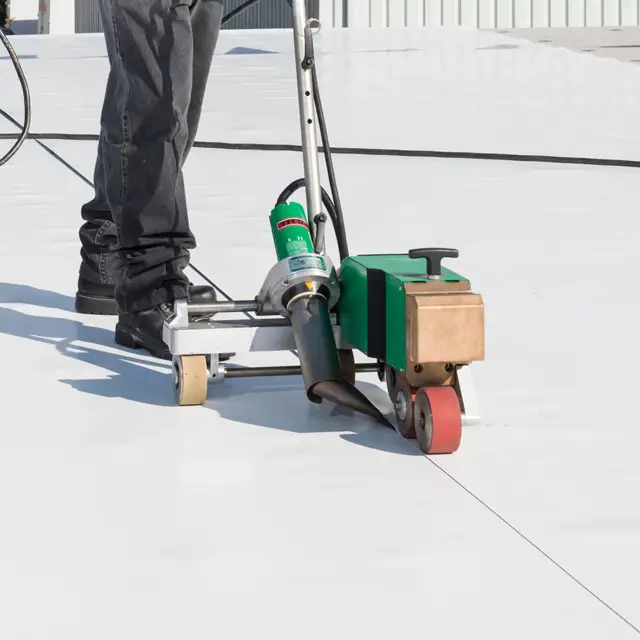
- Colors: White, Gray, Tan, (custom colors available)
- Attachment Method: Fully-Adhered, Mechanically-Fastened, Ballasted
- Seaming or Patching Method: Hot Air Welded
- Asphalt Compatibility: Good
- Resistance to Oils, Coolants, and Grease: Good
- In Use Since: 1980’s
About KEE Single-Ply Roofing Systems
A KEE/PVC roof membrane is a type of roofing material used in low-slope or flat roofing applications. KEE stands for Ketone Ethylene Ester, which is a polymer that is added to PVC (polyvinyl chloride) to make the roofing material more durable and resistant to environmental factors.
The KEE/PVC roofing membrane is made of a single layer of thermoplastic material that is heat-welded together to form a continuous, seamless membrane over the roof surface. These single ply systems are known for durability, resistance to punctures and tears, and resistance to chemical and environmental factors such as UV rays, acid rain, and pollutants.
KEE/PVC roofing membranes are commonly used in commercial roofing applications, but can also be used in residential applications. They are available in a range of colors and thicknesses.
PIB Single-Ply Membrane (Polyisobutylene)
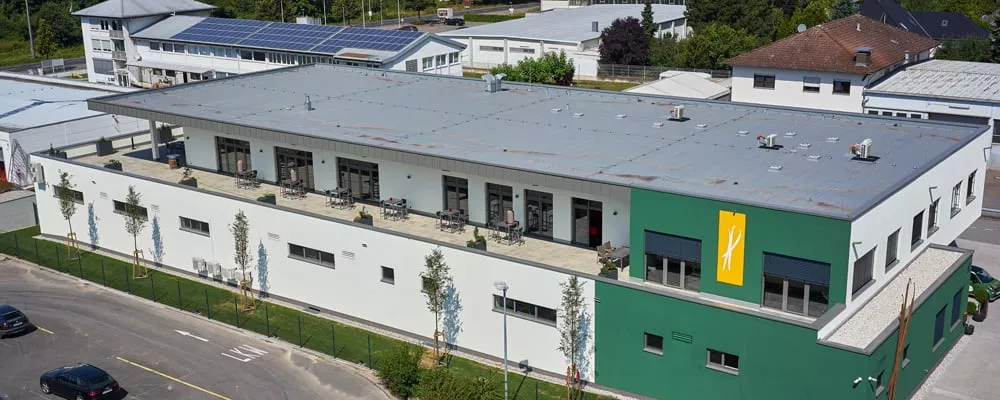
- Colors: Black, Gray, White
- Attachment Method: Fully-Adhered, Mechanically-Fastened, Ballasted
- Seaming or Patching Method: Adhesive or Hot Air Welded
- Asphalt Compatibility: Good
- Resistance to Oils, Coolants, and Grease: Poor
- In Use Since: 1930’s
About PIB Single-Ply Roof Systems
The PIB (polyisobutylene) single-ply membrane, which was created in the 1930s, is the world’s oldest single-ply roofing system. Some roofs made with this material have been in use for over 50 years and are still functional.
PIB was a more common roofing system before the advent EPDM in the 70s, and especially before TPO began to dominate the commercial roofing market starting in the 90s.
It’s unusual to run across a PIB membrane these days, although they are still being manufactured.
PIB is relatively eco-friendly. The PIB membrane has undergone a full life cycle assessment to ISO14040, which indicates the product has no significant environmental impact.
PIB membrane has a self-sealing edge which simplifies installation somewhat.
PIB is normally only available in gray, but there is a copper paint finish (copper flakes suspended in a PIB carrier) which weathers to the color of a natural copper patina.
PVC Single-Ply Membrane Roofing (Polyvinyl Chloride)
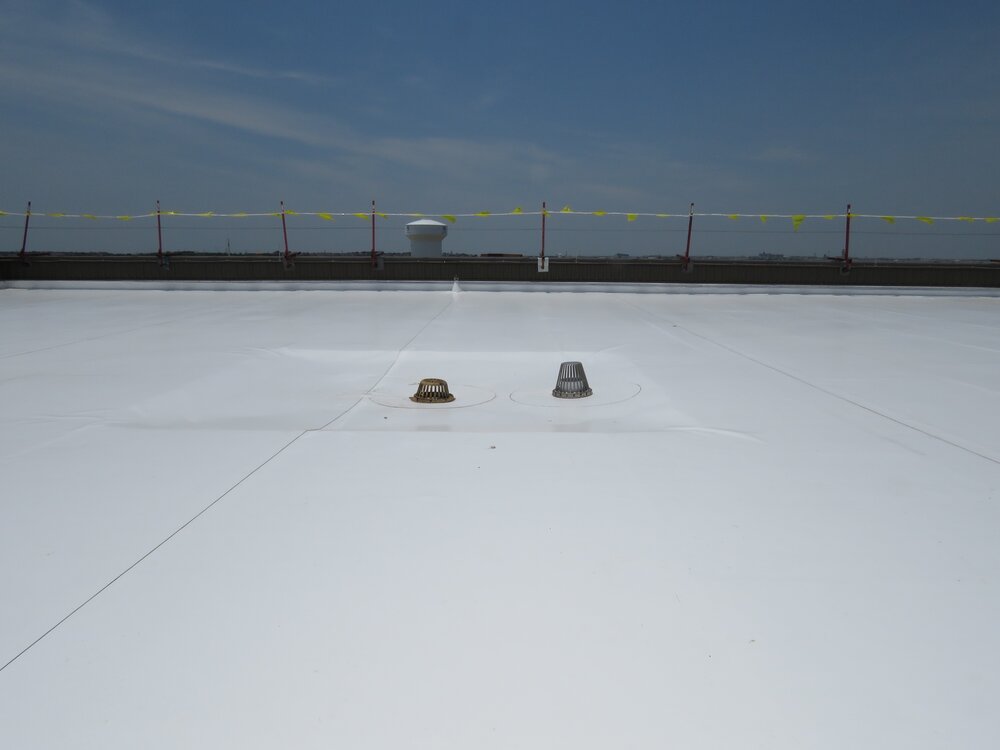
- Colors: White, Gray, Tan, (custom colors available)
- Attachment Method: Fully-Adhered, Mechanically-Fastened
- Seaming or Patching Method: Hot Air Welded
- Asphalt Compatibility: Poor
- Resistance to Oils, Coolants, and Grease: Fair
- In Use Since: Late 1960’s
About PVC Single-Ply Roof Systems
PVC (polyvinyl chloride) roofing is a single-ply membrane that is widely used on commercial and industrial buildings. PVC rounds out the big three in the world of single-ply roofing membranes, being the third-most popular membrane after TPO and EPDM.
PVC is a thermoplastic roofing material; thermoplastic membranes are installed by joining the individual sheets together with heat-welded seams, and they can be repaired using heat-welded patches for the life of the roof.
Chemical plasticizers are added to the PVC during the manufacturing process to ensure flexibility throughout the life of the roof.
PVC is highly resistant to UV rays, chemicals, and extreme temperatures. PVC roofing is relatively tough and long-lasting. It can resist foot traffic better than some other roofing systems. Another advantage of PVC roofing is that it is relatively highly fire-resistant.
It can last for decades if installed correctly and receives proper maintenance.
It is also known for its high reflectivity, which minimizes energy usage by reflecting sunlight and reducing heat absorption by the building.
PVC roofing is fairly easy to install and repair, making it a cost-effective option.
PVC roofing is available in white, gray, and tan. It is also available in a variety of thicknesses, including 45-mil, 60-mil, and 80-mil membranes.
To learn more about PVC, see our PVC Roofing page.
TPE Single-Ply Membrane Roofing (Thermoplastic Polyolefin Elastomer)
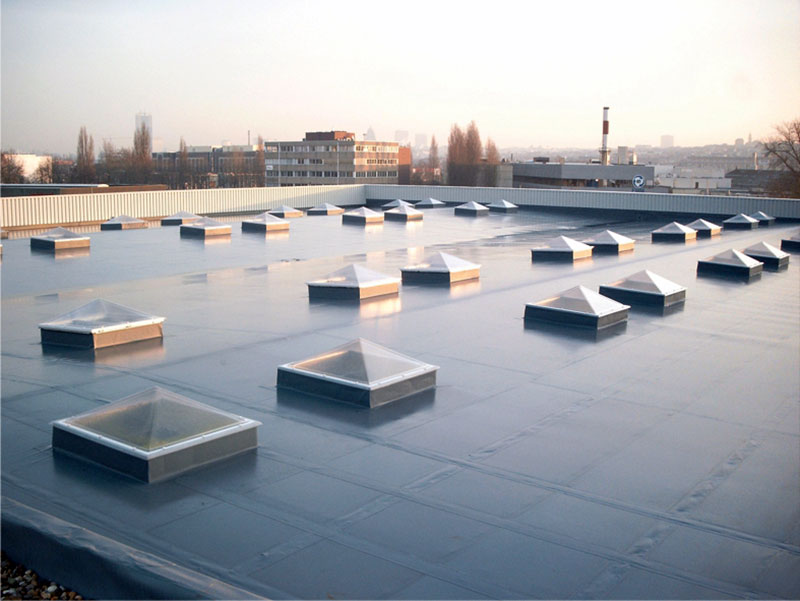
- Colors: Gray
- Attachment Method: Fully-Adhered, Mechanically-Fastened, Ballasted
- Seaming or Patching Method: Hot Air Welded
- Asphalt Compatibility: Good
- Resistance to Oils, Coolants, and Grease: Animal Fats – Excellent; Petroleum – Poor
- In Use Since: 1990’s
About TPE Single-Ply Roofing Systems
TPE stands for thermoplastic polyolefin elastomer. This is a relatively new roofing product developed to improve on some of the drawbacks of regular TPO roofing membranes.
Installing TPE roofing is somewhat easier than other thermoplastic single-ply roofing materials. A significant advantage of TPE over TPO is that it doesn’t have the extreme sensitivity to dirt on the membrane while heat-welding the seams that TPO has. This makes seam welding easier.
Moreover, unlike PVC and TPO, TPE roofing membrane provides successful welding across a wide range of temperatures, which makes the installation process much simpler for the contractor.
TPE roofs are also much easier to repair – small punctures can be resealed through the application of heat, a feature completely absent in PVC and TPO roofing membranes, which require a separate patch to be applied.
TPE roofing membranes combine the positives of PVC, including flexibility and high weldability,, and those of TPO, including being plasticizer-free, chlorine-free, and heavy metal-free.
TPO Single-Ply Membrane Roofing (Thermoplastic Polyolefin)
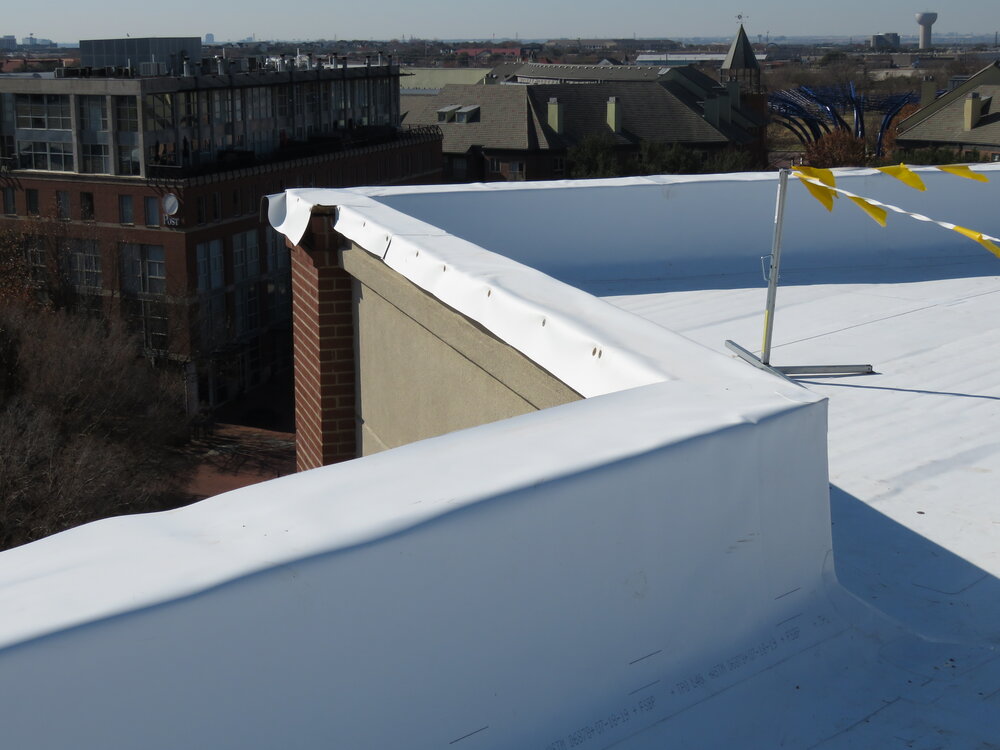
- Color Availability: White, Gray
- Attachment Method: Fully-Adhered, Mechanically-Fastened, Ballasted
- Seaming or Patching Method: Hot Air Welded
- Asphalt Compatibility: Good
- Resistance to Oils, Coolants, and Grease: Animal Fats – Excellent; Petroleum – Poor
- In Use Since: 1980’s
About TPO Single-Ply Roofing Systems
TPO (Thermoplastic Polyolefin) single ply membrane roofing is the most common type of roofing material used in low-slope or flat roofing applications. It is a highly durable, although relatively stiff material, that is resistant to environmental factors, making it an excellent choice for roofing.
TPO single-ply roofing systems are by far the most popular commercial roofing systems being installed today.
TPO roofing systems have a single layer of thermoplastic material that is heat-welded together to form a continuous, seamless membrane.
TPO membranes are available in different thicknesses and can be installed in different ways, such as fully adhered, mechanically attached, or ballasted.
To learn more about TPO systems, see our TPO Roofing page.
About the Author
Jack Gray is a principal roof consultant and vice president at the Moriarty Corporation, an award-winning building enclosure consultant firm founded in 1967. He is also the editor of the Roof Online website.

Mr. Gray has worked in the roofing industry for over 25 years, with training and practical experience in roof installation, roof inspection, roof safety, roof condition assessment, construction estimating, roof design & specification, quality assurance, roof maintenance & repair, and roof asset management.
He was awarded the Registered Roof Observer (RRO) professional credential in 2009.
He also served as an infantry paratrooper in the 82nd Airborne Division and attended Cornell University. Read full bio.